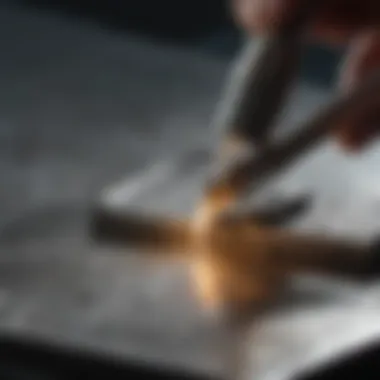Mastering the Art of Silver Solder Torch: A Comprehensive Guide for Artisans


Rock and Fossil Identification
Delve into the intricate world of rock and fossil identification within the realm of silver solder torch artistry. When embarking on the journey of working with a silver solder torch, understanding the types of rocks and fossils that may enhance your creative process is fundamental. Look for distinct characteristics in the rocks and fossils that can bring unique textures or colors to your creations. Utilize specialized tools for identification, ensuring precision and accuracy in selecting the perfect specimens.
Collecting Tips and Techniques
In the realm of silver solder torch craftsmanship, collecting tips and techniques play a vital role in sourcing quality materials. Embrace best practices for collecting rocks and fossils, focusing on ethical and sustainable acquisition methods. Discover prime collecting sites that offer a diverse range of specimens to fuel your artistic endeavors. Learn how to safely extract specimens, preserving their integrity and ensuring they are ready for the soldering torch process.
Preservation and Display
Preservation and display techniques are pivotal in showcasing the beauty of rocks and fossils enhanced by the silver solder torch art form. Safeguard the integrity of your specimens by employing proper preservation methods that maintain their natural allure. Explore creative storage solutions that not only protect but also highlight the unique features of each rock and fossil. Infuse creativity into your display ideas, creating captivating arrangements that showcase the essence of your silver solder torch creations.
Geological Insights
Uncover the geological insights embedded in the art of silver solder torch work. Gain a deeper appreciation for geological formations and processes that influence the characteristics of rocks and fossils used in your creations. Explore the historical significance of specific rocks and fossils, understanding their cultural and scientific value. Delve into notable discoveries in the field of geology, drawing inspiration from the past to enrich your present artistic endeavors.
Introduction to Silver Solder Torch
In this article, we embark on a journey to explore the profound artistry of utilizing a silver solder torch. This introduction sets the stage for a comprehensive guide that will delve into every facet of silver solder torch usage, from fundamental techniques to advanced applications. The significance of mastering this skill resonates not only with artisans but also with enthusiasts seeking to hone their craft. Understanding the intricacies of silver soldering is paramount for anyone looking to create intricate and durable metalwork pieces.
Understanding Silver Soldering
Definition and Principles: The cornerstone of silver soldering lies in its precise fusion method, which involves melting a lower-melting-point silver alloy to join two metal pieces. This technique allows for seamless connections while maintaining the integrity of the materials involved. The principle of capillary action is pivotal in silver soldering, ensuring that the molten solder flows into the joint, creating strong bonds. While this method demands skill and precision, its ability to produce durable and aesthetically pleasing joints makes it a favored choice among artisans.
Types of Silver Solder: Silver solder comes in various compositions tailored to specific applications, each offering distinct melting temperatures and properties. From easy-flow solders for delicate work to hard solders for structural integrity, the versatility of silver solder types allows artisans to cater to diverse project requirements. Selecting the right solder type is crucial for achieving optimal results, as it determines flow behavior, joint strength, and overall finish quality.
Benefits of Silver Soldering: The benefits of silver soldering extend beyond its joint strength and aesthetic appeal. Silver solder exhibits excellent electrical conductivity, making it ideal for creating connections in electronics. Moreover, its malleability and workability facilitate intricate detailing, making it a popular choice for jewelry makers. The high-strength bonds formed through silver soldering ensure longevity and durability in metalwork, reinforcing its position as a premier joining method.
Importance of Torch in Soldering Process
Heat Generation and Control: The torch serves as the heart of the soldering process, providing the heat energy required to melt the solder and bond the metals. Efficient heat generation and control are essential to avoid overheating or underheating, ensuring precise solder flow and joint formation. Mastering heat management is a skill that distinguishes accomplished artisans, allowing them to execute intricate soldering tasks with finesse.
Precision and Versatility: The torch's precision plays a critical role in determining the soldering outcome, influencing joint quality and overall project success. Its versatility enables artisans to work on a wide range of materials and projects, from delicate jewelry components to intricate electronic connections. By wielding the torch with precision, artisans can achieve seamless joints and intricate detailing, elevating the craftsmanship of their creations.
Comparison with Other Soldering Tools: In comparison to alternative soldering tools, such as electric soldering irons or induction heaters, the torch offers unparalleled flexibility and mobility. Its ability to deliver concentrated heat precisely where needed allows for intricate work on varied metal thicknesses and compositions. While each soldering tool has its strengths, the torch stands out for its adaptability and efficiency in achieving precise and aesthetically pleasing solder joints.
Usage in Various Industries
Jewelry Making: Silver solder torch plays a vital role in jewelry making, allowing artisans to fuse intricate metal components with precision. Whether soldering delicate chain links or setting intricate gemstones, the torch enables jewelry makers to create enduring pieces of wearable art. Its versatility and control make it an indispensable tool in crafting bespoke jewelry designs.


Electronics: In the electronics industry, the silver solder torch serves as a key tool for creating robust electrical connections. Its ability to deliver targeted heat ensures precise solder joints, crucial for maintaining electrical conductivity and reliability in electronic devices. From circuit board assembly to component repairs, the torch plays a pivotal role in ensuring electronic devices' functionality and longevity.
Plumbing: Plumbers leverage the silver solder torch for joining copper pipes securely and effectively. The torch's heat control and efficient solder flow enable plumbers to create watertight joints that withstand high pressure and temperature fluctuations. Whether installing new plumbing systems or repairing existing pipelines, the torch's precision and reliability make it an indispensable tool in the plumbing industry.
Equipment and Tools
Essential Components
Torch Types
When it comes to torch types, the choice significantly impacts the quality and efficiency of the soldering process. The torch's design, fuel type, and flame characteristics determine its suitability for various soldering tasks. For this article, we highlight the importance of selecting the right torch type based on the specific requirements of silver soldering. Whether it's a butane torch for intricate jewelry work or a propane torch for more significant metal pieces, understanding the unique features and advantages of each torch type is paramount in achieving successful outcomes.
Soldering Iron
The soldering iron is a fundamental tool in silver soldering, providing the necessary heat to melt the solder and join metals together. Its temperature control, tip design, and ergonomic features contribute to its effectiveness in intricate soldering tasks. In this article, we emphasize the crucial role of the soldering iron in achieving precise and clean solder joints. Whether it's a portable pen iron for small-scale projects or a soldering station for complex soldering operations, the soldering iron's unique features and advantages are essential considerations for artisans engaging in silver soldering.
Flux and Cleaning Materials
Flux and cleaning materials are indispensable components in silver soldering, facilitating metal cleaning, oxide removal, and solder flow. The selection of the right flux type, whether liquid or paste, and compatible cleaning materials ensures proper joint formation and durability. In this article, we shed light on the significance of using appropriate flux and cleaning materials to enhance solder adhesion and prevent oxidation during the soldering process. By detailing the unique features and advantages of various flux and cleaning products, artisans can make informed decisions to optimize their soldering outcomes.
Advanced Equipment
Bench Burners
Bench burners are advanced torch systems that offer higher heat output and precision control for intricate soldering tasks. Their stability, flame adjustability, and specialized tips make them a valuable asset for professional jewelers and metalworkers. In this article, we emphasize the benefits of using bench burners for complex soldering projects, highlighting their unique features and advantages in enhancing solder flow and metal joining. Understanding the specific characteristics of bench burners allows artisans to elevate their soldering capabilities and achieve exceptional results.
Heating Systems
Heating systems play a pivotal role in providing consistent and regulated heat for soldering different metal alloys. Whether it's a traditional soldering hearth or a modern induction heater, the choice of heating system impacts the efficiency and quality of solder joints. In this article, we underline the importance of selecting the appropriate heating system based on the metal type and soldering requirements. By discussing the unique features and advantages of various heating systems, artisans can optimize their soldering techniques and ensure uniform metal bonding.
Protective Gear
Protective gear is essential when working with a silver solder torch to ensure the safety and well-being of the artisan. Safety glasses, heat-resistant gloves, and aprons shield against heat, sparks, and metal splashes, reducing the risk of injuries. In this article, we stress the significance of wearing appropriate protective gear during soldering activities to prevent accidents and burns. By outlining the key characteristics and advantages of different protective gear options, artisans can prioritize safety in their work environments and focus on achieving superior soldering results.
Maintenance and Safety Tips
Cleaning Procedures
Effective cleaning procedures are essential for maintaining the longevity and performance of soldering equipment. Regular cleaning of soldering irons, torch tips, and work surfaces prevents oxidation buildup and ensures consistent heat transfer. In this article, we emphasize the importance of incorporating proper cleaning procedures into the soldering routine to optimize equipment lifespan and soldering quality. By outlining detailed cleaning methods and the advantages of maintaining clean soldering tools, artisans can enhance their work efficiency and prolong the durability of their equipment.


Handling Gas Cylinders
Safe handling of gas cylinders is paramount in ensuring a secure working environment during soldering activities. Proper storage, transportation, and usage of gas cylinders minimize the risk of leaks, fires, and explosions. In this article, we highlight the best practices for handling gas cylinders, focusing on safety measures and protocols that mitigate potential hazards. By emphasizing the unique features and advantages of safe gas cylinder handling techniques, artisans can prioritize workplace safety and maintain a conducive soldering environment.
Fire Prevention Measures
Fire prevention measures are essential components of soldering safety protocols, reducing the risk of accidental fires and property damage. Installing fire extinguishers, maintaining clear workspaces, and having emergency response plans safeguard against unexpected soldering mishaps. In this article, we underscore the critical role of fire prevention measures in ensuring a safe and controlled soldering environment. By detailing specific fire prevention strategies and their advantages in mitigating potential risks, artisans can proactively address fire hazards and uphold workplace safety standards.
Techniques and Applications
In this article, Techniques and Applications play a key role in unraveling the complexities of silver solder torch usage. These elements delve deep into the practicality and artistry of soldering, providing a foundation for artisans to hone their skills. Understanding basic soldering techniques is essential for creating sturdy and aesthetically pleasing joints. Advanced applications elevate the soldering process, enabling artisans to engage in intricate work such as filigree, stone setting, and repair and restoration with precision and finesse.
Basic Soldering Techniques
Flame Control
Flame control stands as a pivotal aspect of soldering, dictating the temperature and behavior of the torch. The key characteristic of flame control lies in its ability to regulate the intensity of heat, crucial for achieving the desired solder flow without damaging the workpiece. In this article, mastering flame control is emphasized for its role in ensuring accurate and consistent soldering results, making it a popular choice among artisans seeking precision in their craft.
Joining Metals
Joining metals is a fundamental technique employed in soldering to create durable connections between different metal pieces. The key characteristic of joining metals lies in the bond strength achieved through proper solder penetration and adhesion. This technique is favored in the article for its versatility in accommodating various metal compositions, making it a reliable choice for artisans working across different projects.
Tacking and Flowing
Tacking and flowing refer to the process of initially positioning pieces together and then establishing a seamless solder flow between them. The unique feature of tacking and flowing is its ability to secure pieces in place before comprehensive soldering, ensuring accurate alignment and joint formation. In this article, tacking and flowing are lauded for their efficiency in preparing workpieces for intricate soldering tasks, offering a strategic advantage to artisans.
Advanced Applications
Filigree Work
Filigree work involves intricate wire shaping and soldering to create delicate ornamentation on metal surfaces. The key characteristic of filigree work lies in its intricacy, requiring precise heat control and dexterity to achieve fine detail. This technique is highly favored in the article for its ability to add a touch of elegance and sophistication to metalwork, offering artisans a unique avenue for artistic expression.
Stone Setting
Stone setting encompasses the art of securing gemstones onto metal settings through meticulous soldering techniques. The key characteristic of stone setting lies in its balance between aesthetics and structural integrity, ensuring stones are safely anchored while maintaining a visually appealing display. This technique is essential in the article for its ability to elevate jewelry making and metalwork to a sophisticated level, showcasing artisan skill and precision.
Repair and Restoration
Repair and restoration involve fixing damaged or worn metal pieces through precise soldering methods aimed at preserving the original design. The key characteristic of repair and restoration lies in the ability to seamlessly mend metal objects while maintaining their structural integrity. This technique is paramount in the article for its contribution to maintaining and reviving metalwork, allowing artisans to breathe new life into cherished pieces while honing their soldering expertise.


Mastering Silver Solder Torch
In this section of the comprehensive guide on Exploring the Art of Silver Solder Torch, we delve into the pivotal aspect of Mastering Silver Solder Torch. Mastering this technique is crucial as it elevates soldering from a mere mechanical process to an art form. The craft and finesse required in mastering the silver solder torch can only be achieved through dedicated practice, honing skills over time to attain a level of proficiency that sets artisans apart. Understanding the nuances of controlling heat, achieving precision in joins, and the versatility of applications are central to mastering this craft.
Practice and Perseverance
Skill Development
Skill Development plays a pivotal role in the journey of mastering the silver solder torch. Through focused practice and experimentation, artisans refine their ability to manipulate the torch with precision, control the flow of solder, and create seamless joints. The key characteristic of Skill Development lies in its gradual progression, where each soldering project serves as a stepping stone towards mastery. The continuous refinement of skills through mindful practice enhances the artisan's craftsmanship, allowing for intricate and harmonious creations.
Experimentation
Experimentation is a fundamental aspect of honing the craft of soldering. By exploring various techniques, adjusting heat levels, and testing different solders, artisans expand their understanding of the soldering process. The key characteristic of Experimentation lies in its role as a catalyst for innovation and growth. Through experimentation, artisans discover new ways to achieve desired effects, overcome challenges, and push the boundaries of traditional soldering methods.
Continuous Learning
Continuous Learning serves as the backbone of skill development in soldering. Artisans committed to mastering the silver solder torch understand the importance of staying updated on current trends, techniques, and tools in the industry. The unique feature of Continuous Learning lies in its ability to keep artisans adaptable and versatile in their craft. By embracing new knowledge and evolving with the field, artisans ensure their work remains relevant and innovative in a dynamic market.
Seeking Expert Guidance
Workshops and Classes
Engaging in Workshops and Classes dedicated to silver solder torch techniques provides artisans with invaluable hands-on experience under the guidance of experts. The key characteristic of Workshops and Classes is the direct interaction and personalized instruction received, allowing artisans to refine their skills in real-time. By immersing themselves in a structured learning environment, artisans benefit from collective knowledge sharing, peer feedback, and mentorship.
Mentorship Programs
Mentorship Programs offer aspiring artisans the opportunity to learn from seasoned professionals, gaining insights, advice, and industry knowledge that can significantly impact their growth. The key characteristic of Mentorship Programs is the one-on-one guidance and support provided, tailored to the individual needs and goals of the apprentice. Through mentorship, artisans receive personalized feedback, skill development strategies, and career guidance, fostering a nurturing environment for skill enhancement.
Online Resources
Accessing Online Resources such as instructional videos, forums, and digital courses provides artisans with a wealth of information at their fingertips. The key characteristic of Online Resources is the convenience and accessibility they offer, allowing artisans to learn at their own pace and on their schedule. By diving into online tutorials, engaging in community discussions, and exploring virtual workshops, artisans can expand their knowledge base, troubleshoot issues, and connect with a global network of fellow enthusiasts.
Showcasing Artistry
Creating Unique Designs
Crafting unique designs is the hallmark of an artisan skilled in the art of soldering. The key characteristic of Creating Unique Designs lies in the ability to merge technical proficiency with creative imagination, giving rise to one-of-a-kind works of art. By experimenting with different soldering techniques, metals, and textures, artisans can unleash their creativity, delivering bespoke pieces that showcase their skill and vision.
Artistic Presentations
Presenting soldered creations in an artistic manner elevates the artisan's work from mere objects to masterful expressions of craftsmanship. The key characteristic of Artistic Presentations is the attention to detail in displaying soldered pieces: from lighting and background selection to composition and storytelling. By curating exhibitions, participating in shows, and sharing work on digital platforms, artisans can captivate audiences and convey the artistry behind their soldered creations.
Portfolio Development
Building a comprehensive portfolio is essential for artisans looking to establish their credibility and reach a wider audience. The key characteristic of Portfolio Development lies in its role as a visual narrative of an artisan's journey, displaying growth, versatility, and signature style. By documenting projects, showcasing collaborations, and presenting a diverse range of works, artisans can attract potential clients, exhibition opportunities, and collaborations, facilitating the growth of their soldering practice.







